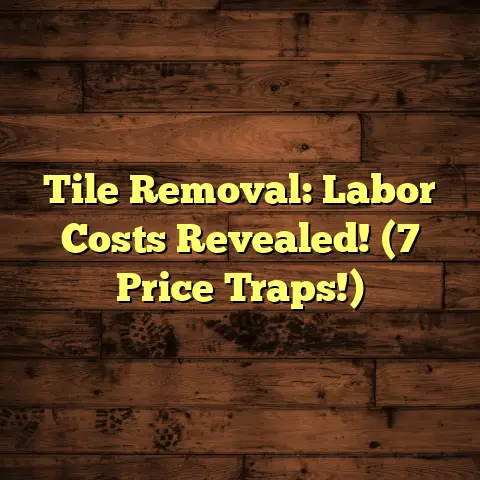Flooring on Uneven Concrete (4 Leveling Blunders!)
Aesthetics matter, right? I mean, who wants a floor that looks like it’s trying to escape the room? Flooring is more than just something to walk on. It sets the tone for your entire space.
Think about it: a beautiful, level floor creates a sense of calm and order. It makes your home feel inviting and well-cared for. A crooked floor? It screams neglect and can even make people feel subconsciously uneasy.
I’ve seen firsthand how a well-designed floor can boost a home’s value and, more importantly, the homeowner’s happiness. I’m talking about the kind of joy that comes from a space that feels both functional and beautiful.
Uneven concrete is especially common in basements, garages, and outdoor patios. These are areas often overlooked, but they have huge potential. The key? Leveling.
In this article, I’m going to share the four biggest leveling blunders I’ve seen over the years. These are the mistakes that can turn your dream floor into a nightmare. So, grab a coffee, and let’s dive in!
Section 1: The Dilemma of Uneven Concrete
What causes this concrete chaos anyway? Well, there are a few usual suspects.
-
Soil Erosion: Water is a powerful force. Over time, it can wash away the soil beneath your concrete slab, causing it to sink and crack. I’ve seen this happen a lot in areas with poor drainage.
-
Settling: New homes are especially prone to settling. As the ground beneath the foundation compacts, the concrete can shift. This is a natural process, but it can lead to uneven surfaces.
-
Poor Installation: Let’s be honest, not all concrete jobs are created equal. If the concrete wasn’t properly poured or cured, it can develop cracks and unevenness down the line.
These imperfections aren’t just cosmetic. They can lead to a whole host of aesthetic issues:
-
Visible Cracks: Cracks are an eyesore. They break up the smooth surface of your floor and make it look old and damaged.
-
Gaps: Uneven concrete can create gaps between your flooring and the subfloor. These gaps not only look bad but can also trap dirt and moisture.
-
Uneven Color Distribution: When flooring is installed on an uneven surface, it can affect how light reflects off it. This can lead to an uneven color distribution, making your floor look patchy.
I remember one client who had installed beautiful hardwood floors in their basement. The problem? The concrete slab was severely uneven. The result was a floor that looked wavy and distorted. The gaps between the planks were so wide you could see the concrete below. It completely ruined the aesthetic they were going for.
The right flooring choice can enhance the beauty of a space, creating a warm and inviting atmosphere. But the wrong choice, especially on uneven concrete, can detract from it, making the space feel cluttered and unappealing.
Section 2: Leveling Blunder #1 – Ignoring the Root Cause
This is a big one, folks. I can’t tell you how many times I’ve seen homeowners try to slap flooring over uneven concrete without addressing the underlying issue.
It’s like putting a band-aid on a broken leg. It might cover up the problem for a little while, but it’s not going to fix it.
The aesthetic ramifications of this blunder are significant. Let’s say you have a crack in your concrete slab caused by soil erosion. You cover it up with vinyl flooring, thinking you’ve solved the problem. But guess what? The erosion continues, and the crack gets bigger. Eventually, the vinyl flooring will start to buckle and crack as well, revealing the problem you tried to hide.
Even worse, ignoring the root cause can lead to further deterioration of the appearance over time. That small crack can turn into a major fissure, and that slight dip in the floor can become a noticeable slope.
I once worked on a project where the homeowner had ignored a water leak that was causing the concrete slab to sink. They installed new tile flooring, thinking it would solve the problem. Within a few months, the tiles started to crack and pop up. The whole floor had to be ripped out, and the underlying water leak had to be fixed. It was a costly and time-consuming mistake.
Instead of just covering up the problem, take the time to identify the root cause. Is it soil erosion? Settling? A water leak? Once you know what’s causing the unevenness, you can address it properly.
This might involve repairing cracks, reinforcing the soil around the foundation, or fixing a plumbing issue. It’s more work upfront, but it will save you a lot of headaches (and money) in the long run.
Section 3: Leveling Blunder #2 – Choosing the Wrong Flooring Material
Not all flooring is created equal, especially when it comes to uneven concrete. Some materials are more forgiving than others. Choosing the wrong flooring can exacerbate aesthetic issues and create a real eyesore.
Thin vinyl planks, for example, are notorious for showing every imperfection in the subfloor. If your concrete is uneven, these planks will conform to the contours, creating a wavy and uneven surface. I’ve seen this happen time and time again.
Certain tiles also require a perfectly leveled base. Large format tiles, in particular, are very unforgiving. If the subfloor isn’t perfectly flat, the tiles can crack or become misaligned.
On the other hand, some materials are better suited for uneven concrete. Carpet, for example, is very forgiving. It can hide minor imperfections and provide a comfortable walking surface.
Engineered hardwood is another good option. It’s more stable than solid hardwood and less likely to warp or buckle on an uneven surface.
I had a client who was determined to install thin vinyl planks in their basement, even though I advised against it. The concrete slab was uneven, with several noticeable dips and cracks. I warned them that the vinyl planks would show every imperfection, but they insisted on going ahead with the project.
The result was a disaster. The vinyl planks looked wavy and uneven, and the cracks in the concrete were clearly visible through the flooring. The client was extremely disappointed and ended up having to rip out the vinyl planks and start over with a different material.
Don’t let this happen to you. Before you choose your flooring, assess the condition of your concrete subfloor. If it’s uneven, consider materials that are more forgiving or invest in leveling the surface before you install your flooring.
Section 4: Leveling Blunder #3 – Skipping the Leveling Process
Okay, let’s talk about shortcuts. I get it. Leveling concrete can be a pain. It’s messy, time-consuming, and requires some skill. But trust me, skipping this step is a recipe for disaster.
I’ve seen homeowners try to rush through the leveling process or skip it altogether, thinking they can get away with it. They might try to use shims or other makeshift solutions to even out the surface. But these solutions are often temporary and can lead to even bigger problems down the road.
The visual consequences of improperly leveled surfaces are significant. Imagine walking into a room and seeing uneven transitions between different flooring materials. It’s jarring and makes the space look unfinished.
Or picture mismatched seams in your flooring. These seams can create a cluttered and unappealing look. Even worse, improperly leveled surfaces can create tripping hazards, making your home unsafe.
I remember one homeowner who decided to install laminate flooring in their kitchen. The concrete subfloor was uneven, but they didn’t bother to level it. They just slapped the laminate flooring down, thinking it would be good enough.
Within a few months, the laminate flooring started to buckle and separate. The seams were uneven, and the floor felt unstable underfoot. The homeowner regretted their decision to bypass proper leveling and ended up having to rip out the entire floor and start over.
Don’t make the same mistake. Take the time to level your concrete properly before you install your flooring. This might involve using a self-leveling compound or hiring a professional to grind down high spots and fill in low spots.
It’s an investment that will pay off in the long run. A properly leveled floor will not only look better but will also last longer and be safer to walk on.
Section 5: Leveling Blunder #4 – Neglecting Professional Help
DIY is great, but sometimes you need to call in the pros. Leveling concrete can be tricky, especially if you’re dealing with major imperfections or complex situations.
I’ve seen homeowners attempt DIY leveling efforts that end in disaster. They might use the wrong materials, misjudge the amount of leveling compound needed, or fail to properly prepare the surface.
The result is often an uneven surface that’s even worse than before. I’ve seen cases where homeowners have had to hire professionals to fix their DIY mistakes, adding to the overall cost of the project.
Consulting with flooring experts can help you avoid these pitfalls and achieve a polished and aesthetically pleasing finish. Professionals have the experience, tools, and knowledge to handle even the most challenging leveling projects.
They can assess the condition of your concrete, recommend the best leveling solutions, and ensure that the job is done correctly. They can also help you choose the right flooring materials for your specific situation.
I worked on a project where the homeowner had attempted to level their concrete basement floor themselves. They used a self-leveling compound, but they didn’t properly prepare the surface. The compound didn’t adhere properly, and the floor ended up being even more uneven than before.
The homeowner was frustrated and discouraged. They called me in to fix the problem. I had to grind down the existing leveling compound, prepare the surface properly, and apply a new layer of self-leveling compound. The result was a perfectly level floor that was ready for flooring.
Don’t be afraid to ask for help. If you’re not confident in your ability to level your concrete properly, hire a professional. It’s an investment that will protect your flooring and ensure a beautiful and long-lasting result.
Conclusion
So, there you have it – the four biggest leveling blunders I’ve seen over the years. Avoiding these mistakes can make all the difference between a stunning, inviting space and a flooring disaster.
Remember, aesthetics matter. Your floors are a major part of your home’s overall look and feel. Take a thoughtful approach to your flooring projects, focusing not only on functionality but also on the visual impact of your choices.
By addressing the root cause of uneven concrete, choosing the right flooring materials, leveling your surface properly, and seeking professional help when needed, you can create a space that reflects your personal style and brings you joy for years to come.
Happy flooring!





